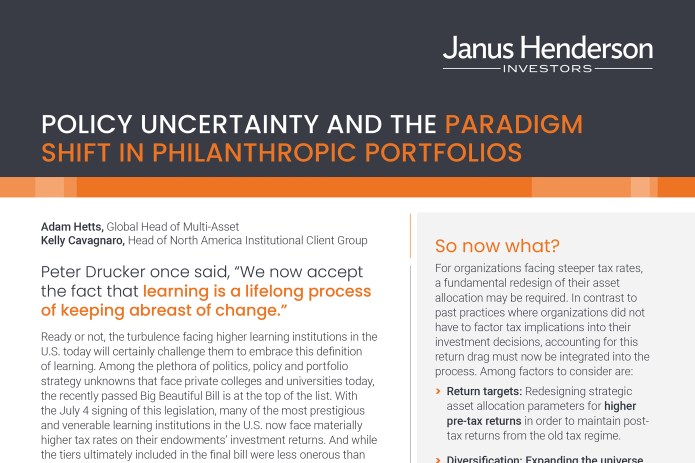
Peter Drucker once said, “We now accept the fact that learning is a lifelong process of keeping abreast of change.”
Ready or not, the turbulence facing higher learning institutions in the U.S. today will certainly challenge them to embrace this definition of learning. Among the plethora of politics, policy and portfolio strategy unknowns that face private colleges and universities today, the recently passed Big Beautiful Bill is at the top of the list. With the July 4 signing of this legislation, many of the most prestigious and venerable learning institutions in the U.S. now face materially higher tax rates on their endowments’ investment returns. And while the tiers ultimately included in the final bill were less onerous than what had been proposed in the initial House version, administrators now must include tax considerations when seeking to achieve their organizations’ investment targets.
Higher tax rates will likely force endowments to make adjustments across their organizations. Decisions include everything from the source of tax payments to potential policy changes to mitigate the tax burden. The meaningfully higher tax rate for the impacted organizations will certainly require changes to portfolios’ asset allocations. For example, the task of generating 8.0% post-tax return, while difficult today becomes all that more challenging when the liquidity profile of that pool changes dramatically.
Investing involves risk, including the possible loss of principal and fluctuation of value.
The information contained herein is for educational purposes only and should not be construed as financial, legal or tax advice.
Differences between compared investments may include objectives, sales and management fees, liquidity, volatility, tax features and other features, which may result in differences in performance.
Any risk management process discussed includes an effort to monitor and manage risk which should not be confused with and does not imply low risk or the ability to control certain risk factors.
Diversification neither assures a profit nor eliminates the risk of experiencing investment losses.